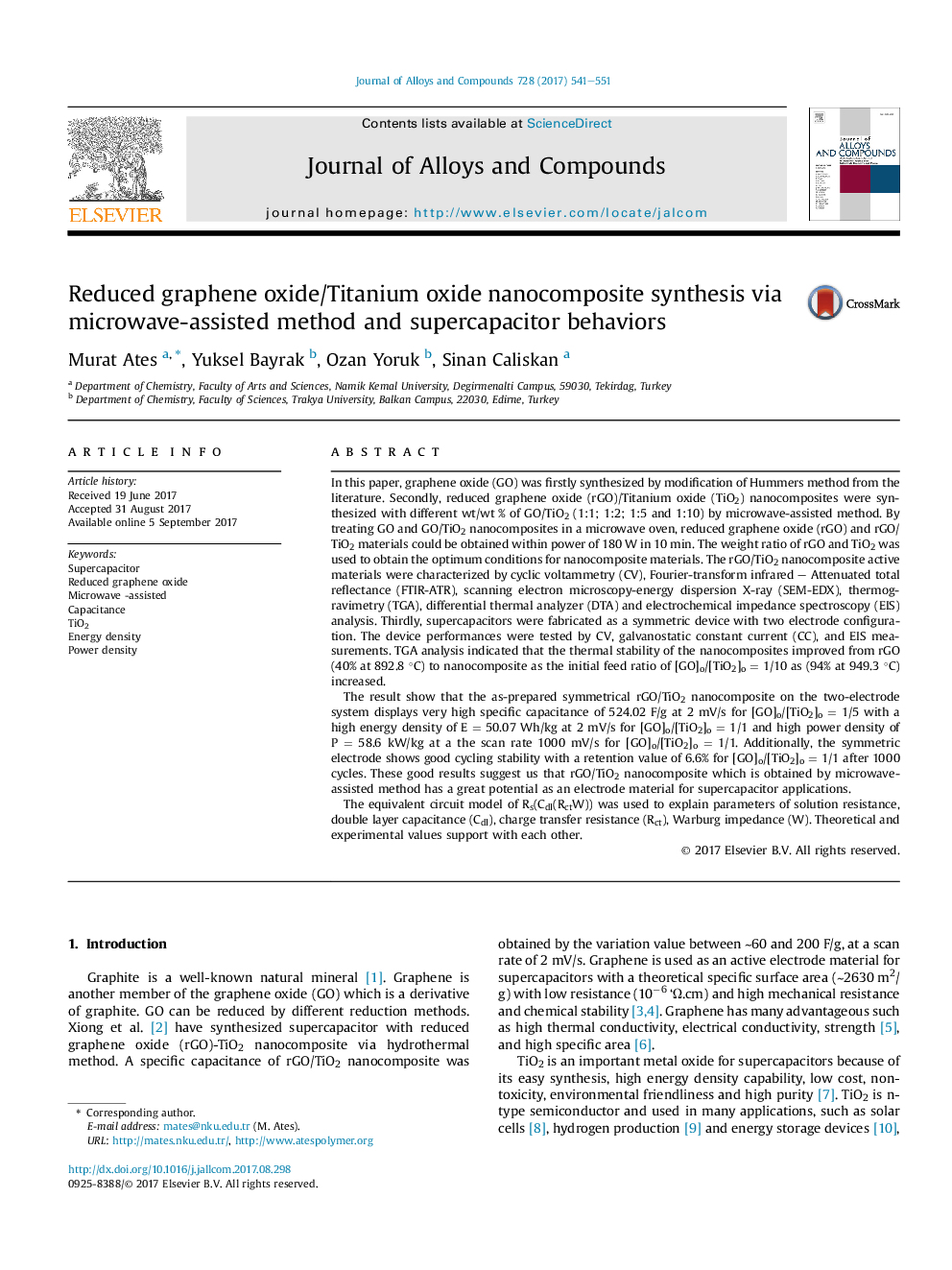| Article ID | Journal | Published Year | Pages | File Type |
|---|---|---|---|---|
| 5458170 | Journal of Alloys and Compounds | 2017 | 11 Pages |
â¢Synthesis of rGO, rGO/TiO2 nanocomposites in the initial feed ratio of [GO]o/[TiO2]o = 1/1, ½, 1/5 and 1/10.â¢Supercapacitor device fabrication of rGO, and rGO/TiO2 nanocomposites in different feed ratios.â¢Energy density, power density and capacitance measurements of rGO, and rGO/TiO2 nanocomposites.
In this paper, graphene oxide (GO) was firstly synthesized by modification of Hummers method from the literature. Secondly, reduced graphene oxide (rGO)/Titanium oxide (TiO2) nanocomposites were synthesized with different wt/wt % of GO/TiO2 (1:1; 1:2; 1:5 and 1:10) by microwave-assisted method. By treating GO and GO/TiO2 nanocomposites in a microwave oven, reduced graphene oxide (rGO) and rGO/TiO2 materials could be obtained within power of 180 W in 10 min. The weight ratio of rGO and TiO2 was used to obtain the optimum conditions for nanocomposite materials. The rGO/TiO2 nanocomposite active materials were characterized by cyclic voltammetry (CV), Fourier-transform infrared - Attenuated total reflectance (FTIR-ATR), scanning electron microscopy-energy dispersion X-ray (SEM-EDX), thermogravimetry (TGA), differential thermal analyzer (DTA) and electrochemical impedance spectroscopy (EIS) analysis. Thirdly, supercapacitors were fabricated as a symmetric device with two electrode configuration. The device performances were tested by CV, galvanostatic constant current (CC), and EIS measurements. TGA analysis indicated that the thermal stability of the nanocomposites improved from rGO (40% at 892.8 °C) to nanocomposite as the initial feed ratio of [GO]o/[TiO2]o = 1/10 as (94% at 949.3 °C) increased.The result show that the as-prepared symmetrical rGO/TiO2 nanocomposite on the two-electrode system displays very high specific capacitance of 524.02 F/g at 2 mV/s for [GO]o/[TiO2]o = 1/5 with a high energy density of E = 50.07 Wh/kg at 2 mV/s for [GO]o/[TiO2]o = 1/1 and high power density of P = 58.6 kW/kg at a the scan rate 1000 mV/s for [GO]o/[TiO2]o = 1/1. Additionally, the symmetric electrode shows good cycling stability with a retention value of 6.6% for [GO]o/[TiO2]o = 1/1 after 1000 cycles. These good results suggest us that rGO/TiO2 nanocomposite which is obtained by microwave-assisted method has a great potential as an electrode material for supercapacitor applications.The equivalent circuit model of Rs(Cdl(RctW)) was used to explain parameters of solution resistance, double layer capacitance (Cdl), charge transfer resistance (Rct), Warburg impedance (W). Theoretical and experimental values support with each other.
Graphical abstractDownload high-res image (282KB)Download full-size image
